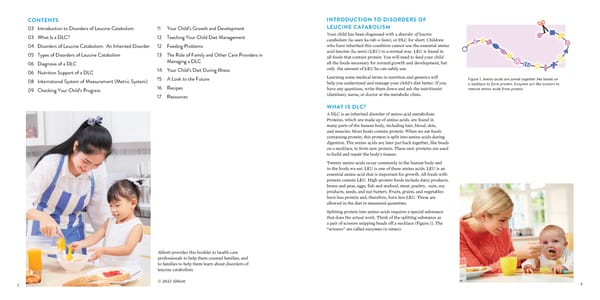CONTENTS INTRODUCTION TO DISORDERS OF 03 Introduction to Disorders of Leucine Catabolism 11 Your Child’s Growth and Development LEUCINE CATABOLISM 03 What Is a DLC? 12 Teaching Your Child Diet Management Your child has been diagnosed with a disorder of leucine catabolism (lu-seen ka-tab-o-lism), or DLC for short. Children 04 Disorders of Leucine Catabolism: An Inherited Disorder 12 Feeding Problems who have inherited this condition cannot use the essential amino 05 Types of Disorders of Leucine Catabolism 13 The Role of Family and Other Care Providers in acid leucine (lu-seen) (LEU) in a normal way. LEU is found in Managing a DLC all foods that contain protein. You will need to feed your child 06 Diagnosis of a DLC all the foods necessary for normal growth and development, but 06 Nutrition Support of a DLC 14 Your Child’s Diet During Illness only the amount of LEU he can safely use. 08 International System of Measurement (Metric System) 15 A Look to the Future Learning some medical terms in nutrition and genetics will Figure 1. Amino acids are joined together like beads on 16 Recipes help you understand and manage your child’s diet better. If you a necklace to form protein. Enzymes act like scissors to 09 Checking Your Child’s Progress have any questions, write them down and ask the nutritionist remove amino acids from protein. 17 Resources (dietitian), nurse, or doctor at the metabolic clinic. WHAT IS DLC? A DLC is an inherited disorder of amino acid metabolism. Proteins, which are made up of amino acids, are found in many parts of the human body, including hair, blood, skin, and muscles. Most foods contain protein. When we eat foods containing protein, this protein is split into amino acids during digestion. The amino acids are later put back together, like beads on a necklace, to form new protein. These new proteins are used to build and repair the body’s tissues. Twenty amino acids occur commonly in the human body and in the foods we eat. LEU is one of these amino acids. LEU is an essential amino acid that is important for growth. All foods with protein contain LEU. High-protein foods include dairy products, beans and peas, eggs, fish and seafood, meat, poultry, nuts, soy products, seeds, and nut butters. Fruits, grains, and vegetables have less protein and, therefore, have less LEU. These are allowed in the diet in measured quantities. Splitting protein into amino acids requires a special substance that does the actual work. Think of the splitting substance as a pair of scissors snipping beads off a necklace (Figure 1). The “scissors” are called enzymes (n-simes). Abbott provides this booklet to health care professionals to help them counsel families, and to families to help them learn about disorders of leucine catabolism. 2 © 2023 Abbott 3
 A Guide for Understanding Disorders of Leucine Catabolism (DLC) Page 1 Page 3
A Guide for Understanding Disorders of Leucine Catabolism (DLC) Page 1 Page 3